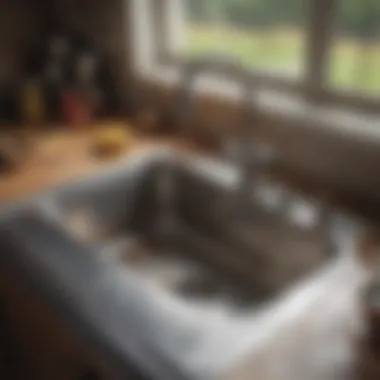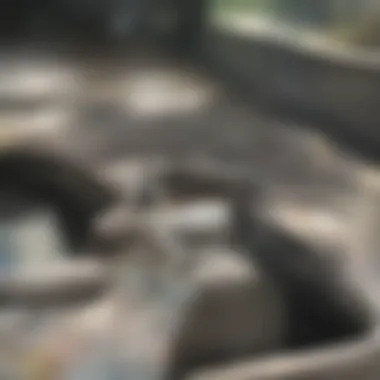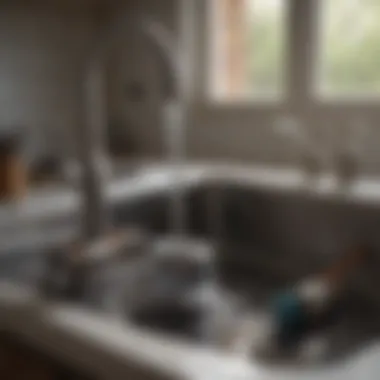Comprehensive Insights on Kitchen Sink Drainage Issues


Intro
Unresolved drainage issues in kitchen sinks present a common but critical challenge for homeowners. Understanding the intricacies of these problems is essential for effective management. The implications of a malfunctioning sink can go beyond mere inconvenience, often leading to unsightly messes and potential health hazards. By identifying the root causes and solutions, one can maintain a functional and efficient kitchen.
Here, we delve into diverse aspects of kitchen sink drainage problems. We will explore practical diagnostic methods, preventive maintenance practices, and the most common obstructions that might lead to drainage failures. For those who prefer to take action on their own, we will also provide insights into DIY options and when it is prudent to engage professional plumbers. Each subsection aims to equip readers with both knowledge and tools for management of this essential home feature.
This guide seeks to demystify kitchen plumbing issues, presenting a blend of practical advice and technical understanding. With a focus on empowering homeowners and property managers, it serves as a comprehensive resource for anyone facing the often frustrating task of dealing with drainage inefficiencies.
Understanding Kitchen Drainage
Understanding kitchen drainage is vital for maintaining a functioning home environment. Efficient drainage impacts not only the convenience of daily tasks but also the overall hygiene of the kitchen. A well-working drainage system prevents unpleasant odors and the risk of pests, which can arise from waste accumulation. To grasp the breadth of this topic, one must consider the design of the system, its components, and how each plays a role in effective water flow.
Importance of Efficient Drainage
Efficient drainage is central to a well-primary kitchen experience. Without it, water may pool in sinks or flow slowly, leading to frustration. The consequences of poor drainage can range from minor inconveniences to serious plumbing issues. When water freely flows, it safeguards against the buildup of bacteria and mold, which can compromise food safety. Also, a properly functioning drainage system can save money on repairs and help maintain the integrity of plumbing fixtures and piping over time. When the system is efficient, it enhances the durability of appliances and reduces the likelihood of needing extensive repairs.
Common Vocabulary in Drainage
Being familiar with key terms in drainage systems can aid in understanding their function and identifying issues. Here are some important terms to know:
- Drains: Openings that allow water and waste to exit sinks, tubs, and appliances.
- Pipes: Tubes used to transport water and waste from the drain to the sewer or septic system.
- S Traps: Curved pipes that prevent odors from coming back up the drain by creating a water seal.
- Vent Pipes: Pipes that allow air to enter the drainage system, preventing vacuum effects that would slow the drainage process.
Understanding these terms not only enhances communication with professionals but also equips homeowners with the knowledge to conduct simple maintenance and troubleshoot potential problems.
Typical Causes of Poor Drainage
Understanding the typical causes of poor drainage is essential for homeowners and property managers alike. Knowing these causes can help in identifying problems early on. This knowledge allows for timely interventions before minor issues escalate into significant damage or costly repairs. The integrity of plumbing systems relies heavily on maintaining suitable drainage conditions. Poor drainage can lead to not only inconveniences but also health risks from stagnant water and mold growth.
Clogs and Obstructions
Clogs are often the most recognized cause of poor drainage. In kitchen sinks, food debris, grease, and soap residues frequently accumulate, leading to significant blockages. When water cannot flow freely, it backs up, creating unpleasant odors and slow drainage. The most common materials contributing to clogs include
- Food particles: Small bits of food can accumulate in the pipes, especially if a garbage disposal is not used properly.
- Grease: Fats and oils solidify inside the pipes, creating a barrier that traps other debris.
- Soap scum: Soap residues combine with minerals from water, leading to hard buildups.
Regular maintenance can prevent these obstructions. Homeowners should avoid sending inappropriate materials down the sink. Using a drain strainer can effectively catch food particles before they enter the plumbing system.
Pipe Damage or Corrosion
Pipe damage or corrosion often causes slow drainage. Older pipes, made from materials like iron or galvanized steel, are prone to deterioration. Corroded pipes can develop holes or rust, leading to leaks. Furthermore, this damage influences the water flow, causing backups and slow drainage.
Homeowners should be aware of the age of their plumbing systems. Signs of pipe damage may include:
- Discoloration: Staining around fittings or beneath sinks can indicate leaks.
- Unusual sounds: Gurgling noises in the plumbing system may suggest air pockets caused by damaged pipes.
Replacing old or damaged pipes with modern materials, such as PVC or PEX, can resolve these drainage issues.
Ventilation Issues
Ventilation plays a crucial role in the proper functioning of drainage systems. Plumbing systems require adequate air to function effectively. Without sufficient ventilation, drains may experience siphoning, where water is removed too quickly, leading to slow drainage or even complete blockages.
Common signs of ventilation problems include:
- Gurgling sounds: Indicate that air cannot move freely through the system.
- Slow drainage: When aired drains cannot operate efficiently.
To improve ventilation, homeowners should ensure that vent pipes are not obstructed or damaged. Regular inspections can help identify potential issues before they worsen.
Proper knowledge of the causes of poor drainage allows for preventative measures, avoiding costly repairs and maintaining a healthy home environment.
Identifying Drainage Problems
Identifying drainage problems is a crucial step towards effective kitchen maintenance. Poor drainage can lead to a series of issues, such as unpleasant odors, unsanitary conditions, and even structural damage to property. When you recognize the following signs early, you can save time and money on repairs. Furthermore, understanding these problems helps homeowners appreciate the mechanics of their kitchens.


Symptoms of Poor Drainage
Several indicators suggest that a drain issue may be present. These symptoms often manifest themselves in everyday situations, such as:
- Slow draining water may indicate blockages somewhere in the system.
- Unpleasant smells can arise from decomposing food caught in pipes.
- Gurgling noises usually signal air trapped in lines affected by clogs.
- Water backups in sinks suggest that there is a more extensive blockage downstream.
Recognizing these symptoms early allows you to take action before they escalate. When multiple symptoms occur simultaneously, it points towards more severe drainage issues that cannot be ignored.
Simple Tests for Blockages
Identifying a blockage requires simple tests that homeowners can perform with minimal tools. These tests help pinpoint the type and location of the problem.
Water Flow Tests
Water flow tests are essential for understanding how well your drainage system functions. This test involves running hot water through the sink and observing the drainage speed. If the water clears quickly, your pipes are likely in good condition. On the other hand, if the water pools or drains slowly, there may be an obstruction in the pipes.
Key Characteristics:
The ability to conduct this test with basic items from home makes it a practical and beneficial approach. Monitoring the speed of the water gives immediate feedback on the state of your drains.
Advantages:
Water flow tests are easy to understand and require no specialised equipment. They provide immediate insights into your drainage issues, facilitating prompt action if problems are detected.
Disadvantages:
While effective, this method does not pinpoint the exact location of a blockage. Further investigation may still be required.
Use of Food Coloring
The use of food coloring serves as a unique method to detect leaks or drainage issues as well. Adding a few drops of food coloring into the sink allows you to monitor how quickly and where the color travels throughout the drain.
Key Characteristics:
This method highlights leaks in drainage systems effectively and uniquely. It shows not only whether water is draining properly but also whether it is leaking into unintended areas.
Advantages:
Utilizing food coloring is harmless, cost-effective, and provides clear indicators of drainage health. This method helps visualize problems that are otherwise hidden.
Disadvantages:
The limitation is that this test mainly detects leaks rather than full blockages. If there is no visual change, it may indicate that other issues are at play.
By familiarizing yourself with common symptoms and performing simple tests, you bolster your ability to manage kitchen drainage issues effectively.
preventative Maintenance
Preventive maintenance plays a vital role in ensuring that kitchen sink drainage systems remain functional without major disruptions. This aspect helps to avoid significant clogs and damages over time, which can lead to costly repairs. Implementing regular maintenance can enhance the efficiency of drainage systems while extending their lifespan.
Here are some important elements to consider when looking at preventative maintenance:
- Consistency: Regular maintenance routines are key. Simple practices performed consistently can prevent dirt and debris accumulation in the drainage system.
- Inspection: Periodic checks allow homeowners to catch potential issues before they escalate into serious problems. This proactive approach can save time and resources eventually.
- Education: Understanding how drains work is fundamental. Homeowners should know what can go down the drain and what should be avoided.
Benefits of preventative maintenance are numerous:
- Cost savings: By addressing small issues before they become big problems, you can save a significant amount on repair costs.
- Peace of mind: Knowing that your drainage systems are well-maintained can reduce anxiety about unexpected clogging.
- Improved functionality: Regular cleanings maintain optimal flow rate, making the kitchen more efficient for daily tasks.
In summary, preventative maintenance fosters an environment where kitchen sink drainages can function well, making cleanup easier and extending their lifespan.
Dealing with Obstructions
In the realm of kitchen sink drainage, dealing with obstructions is a fundamental concern. This section aims to clarify common types of blockages and effective methods to eliminate them. Understanding the nature of these obstructions helps homeowners maintain efficient drainage systems. This knowledge can prevent minor issues from escalating into significant problems, saving time and money in repairs.
Common Blockages to Expect
Food Debris
Food debris represents a major contributor to kitchen sink clogs. In many households, remnants of food such as small scraps can accumulate in the drain over time. These particles often come from inadequate disposal practices, like rinsing dishes under the tap. While food debris seems innocuous, it can lead to more significant drainage issues if allowed to build up.
A key characteristic of food debris is its variability. Different types of food can break down differently in water. For instance, starchy items like pasta can quickly thicken and create a paste-like substance when wet, thus forming clogs.
The notable element of food debris is its potential for creating larger blockages. If ignored, it presents disadvantages as it may lead to unpleasant odors and attract pests. Hence, taking preventive steps to minimize food waste entering the sink can be beneficial.


Grease Build-up
Grease build-up is another common obstruction found in kitchen sink drainage. When cooking, oils and fats are often washed down the drain. Initially, they might flow smoothly, but as they cool, they solidify and stick to the interior of pipes. This accumulation can drastically reduce water flow.
The primary factor making grease build-up a significant issue is its adhesive nature. Unlike food particles, grease binds with the walls of pipes, creating a barrier that can trap additional debris.
Additionally, grease build-up can lead to serious plumbing issues over time. It can cause complete blockages if not addressed, resulting in costly repairs. For homeowners, understanding this unique feature of grease is essential for developing effective long-term drainage maintenance plans.
Methods for Clearing Clogs
Plunging Techniques
Plunging is a frequently used method for clearing clogs in kitchen sinks. This technique employs a simple yet effective device called a plunger. By creating suction, a plunger can dislodge blockages. It is most beneficial when obstructions are minor.
A key characteristic of plunging is its accessibility. Most households have a plunger available, making it a convenient first step. The unique advantage of this method is that it doesn't require specialized training or tools—just a bit of effort.
However, it has its limitations. A plunger may not be effective for severe clogs or those deeper in the plumbing system. Knowing when to use this method is important for avoiding complications.
Snake Tools
Snake tools, also known as drain snakes or augers, serve as a more advanced solution for clearing clogs. These tools consist of a flexible metal cable that can reach deep into drains to break up or retrieve blockages. Snake tools are especially useful for more stubborn clogs that plungers cannot handle.
One crucial aspect of using snake tools is their reach. These tools can extend into pipes that are not easily accessible. A great advantage is their ability to target and remove more complex blockages directly.
Despite their effectiveness, using a snake tool requires a certain level of skill. Improper use can damage pipes, so one should consider seeking guidance or watching a tutorial before attempting to use one. Understanding these methods for clearing clogs offers practical insight for homeowners combatting drainage problems.
Understanding Drainage Components
In order to comprehend kitchen sink drainage issues fully, it's crucial to understand the components involved. Each element, from the sink itself to the piping systems, plays a vital role in overall functionality. Knowledge of these components helps homeowners identify problems early, enabling timely interventions that could prevent larger issues from developing. Additionally, understanding these aspects aids in making informed decisions regarding maintenance and repairs.
Sinks and Fixtures
Sinks and fixtures are essential in any kitchen. They provide the primary interface for managing wastewater. Different styles and materials of sinks can influence drainage efficiency. For instance, a deeper sink may require specific considerations for the drainage pipe layout, as it can generate more water volume during use.
Common materials include stainless steel, porcelain, and composite. Each type has its benefits and drawbacks concerning durability, maintenance, and design aesthetics. Proper installation is also critical. A poorly installed sink can lead to misalignments in the drainage, causing problems over time. A well-installed fixture aligns properly with the drainage system, ensuring smooth water flow.
Piping Systems
Piping systems are equally important. They are the network through which waste and water flow. If there are issues in the piping, drainage will likely be affected.
Types of Pipes
The types of pipes used in kitchen drainage systems significantly impact performance. Common materials include PVC, ABS, and metal pipes.
- PVC (Polyvinyl Chloride): This type is popular due to its lightweight nature, resistance to corrosion, and ease of installation. It is also a cost-effective choice, making it favorable for many homeowners. However, PVC can become brittle over time, particularly in extreme temperatures.
- ABS (Acrylonitrile Butadiene Styrene): Similar to PVC but generally thicker, ABS is known for its durability and strength. It is often used in residential settings but is prone to discoloration over long periods.
- Metal Pipes: Though less common in modern homes, metal pipes, particularly copper, are known for their longevity. They resist damage from various substances. However, their cost and the difficulty of installation make them less favorable compared to plastic options.
System Layout
The system layout refers to the arrangement of pipes and fittings in relation to the sink and its fixtures. An efficient layout is essential to effective drainage. A layout that adheres to proper guidelines ensures quick water flow, minimizing the risk of clogs.
For example, pipes should ideally slope downward from the sink to the main drainage system. This slope facilitates gravity's role in moving water away more effectively. On the other hand, a poorly designed layout can lead to standing water, which may contribute to clogs or even leaks.
In summary, understanding the drainage components of your kitchen sink is vital. Knowledge of sinks, fixtures, and piping systems can empower homeowners to maintain their systems more effectively and identify potential issues quickly. This proactive approach not only saves time but also can prevent costly repairs down the line.
When to Seek Professional Help
In the realm of kitchen plumbing, there are instances where DIY solutions may not suffice. Knowing when to bring in a professional is crucial for both effective repairs and long-term maintenance of your kitchen's drainage system. Attempting to resolve serious issues without adequate skills or tools can lead to further complications or even damage.
Typically, the signs that indicate a need for professional assistance are not always obvious but can save significant time and headaches when caught early. In this section, we will explore the signs that signal major issues and what considerations should guide your decision regarding hiring a plumber.
Signs of Major Issues


Several key signs suggest that your kitchen sink drainage issues may be beyond simple fixes:
- Persistent Clogs: If clogs reoccur despite multiple attempts to clear them, it might indicate deeper issues within your plumbing infrastructure.
- Bad Odors: An unpleasant smell emanating from the sink can point to underlying problems, possibly related to trapped food debris or problems within the sewage system itself.
- Slow Drainage: If water is not draining as quickly as it should, this could either be an indication of a blockage or a more serious plumbing issue that warrants inspection.
- Frequent Back-ups: Regular back-ups are symptoms of potential issues with your drainage system, indicating either blockages or possible pipe damage.
- Visible Water Damage: Any signs of moisture or leakage around the sink, cabinetry, or walls can suggest significant plumbing issues. Promptly addressing these can prevent further damage to your property.
"Ignoring these warning signs can lead to expensive repairs and significant disruption to your daily life."
Cost Considerations
Evaluating the costs associated with professional plumbing services can influence your decision when dealing with drainage problems. Understanding these costs involves several factors:
- Service Call Fees: Most plumbers charge a fee for the first visit, which may cover inspection and diagnosis. This fee can vary widely based on region and service provider.
- Repair Costs: Depending on the issue, repairs can range from minor fixes like unclogging to major work such as pipe replacement. Get estimates from multiple professionals to find a fair price.
- Long-term Value: While the upfront cost of hiring a professional can seem high, quality repairs can save money in the long run. Poorly managed drainage can lead to extensive damage, costing more than just fixing the immediate problem.
- Preventive Measures: Many plumbers offer maintenance services that can help avoid future problems, often at a reduced cost when compared to emergency repairs.
Preventing Future Drainage Issues
Preventing future drainage issues is capturing a key aspect of kitchen upkeep. When a kitchen drain is not functioning properly, it can create disruptions in everyday tasks. Therefore, adopting proactive measures is essential for maintaining efficient drainage over the long term. A well-maintained drainage system reduces the risk of clogs and associated plumbing costs. Homeowners must invest time in understanding how to oversee their kitchen drains to avoid future complications.
Long-term Maintenance Plans
Long-term maintenance plans are vital. These plans help ensure that drainage systems remain in good shape. Regular maintenance extends the life of pipes and fixtures. A consistent cleaning schedule, along with inspections, can spot issues before they escalate. Consider marking your calendar to review drain health every season. Make a list of tasks, such as cleaning out the trap and checking for leaks.
- Inspect pipes for corrosion or damage regularly.
- Clean strainers to remove food debris.
- Utilize hot water weekly to help dissolve grease.
- Avoid harsh chemicals that can damage your plumbing.
Taking these simple steps creates a stable system that withstands the test of time.
Choosing the Right Products
Choosing the right products is crucial. Not every product works effectively in every instance. Understanding what suits your needs can make a significant difference.
Eco-Friendly Options
Eco-friendly options focus on natural ingredients. They minimize environmental impact while still being effective. Products such as baking soda and vinegar can clean drains without harmful chemicals. These ingredients work together to break down buildup safely. The key characteristic of these options is their biodegradable nature. Their composition often leads to fewer health risks and is generally safe for septic systems.
Benefits of eco-friendly products include:
- Safety for users and pets
- Reduced chemical exposure in your home
- Less impact on the environment
However, these options may take longer to see results compared to harsher chemicals. They are best for regular maintenance rather than dealing with severe clogs.
Effective Drain Cleaners
Effective drain cleaners offer immediate solutions for serious blockages. They contain more potent ingredients designed to dissolve tough materials quickly. Products like Drano and Liquid-Plumr are commonly available. They work by using chemical reactions to break apart clogs. The key characteristic of these cleaners is their speed.
Benefits of effective drain cleaners include:
- Fast action for urgent problems
- Targeted removal of specific types of clogs
The downside can be potential harm to pipes over time if used excessively. Users must balance immediate results with long-term effects for the drainage system.
End
The conclusion of this article synthesizes the vital themes surrounding kitchen sink drainage issues. An effective drainage system is not just a matter of convenience; it is crucial for maintaining a healthy and functional home environment. The insights provided throughout this article directly relate to everyday challenges many homeowners face. Addressing drainage issues often leads to significant benefits, including minimizing unpleasant odors, preventing water damage, and safeguarding overall plumbing integrity.
Recap of Key Points
Addressing kitchen sink drainage effectively involves understanding multiple facets:
- Common Causes: Clogs, pipe damage, and ventilation problems are primary contributors to poor drainage.
- Symptoms: Recognizing early signs of drainage issues can prevent more severe problems. These include slow drainage, gurgling sounds, and foul smells.
- Prevention: Regular maintenance practices are essential. Utilizing methods like hot water flushes and natural drain cleaners can keep pipes clear.
- When to Consult Professionals: Some situations, such as persistent problems or evident pipe damage, demand expert interventions.
This recap underscores the importance of proactive measures and informed responses to drainage concerns.
Final Recommendations for Homeowners
To effectively manage kitchen sink drainage, consider these recommendations:
- Establish a Routine: Regularly clean and maintain your sink and drainage system. Simple practices can avert larger issues.
- Invest in Quality Products: When choosing cleaning solutions, consider eco-friendly options. These not only help the environment but are also safe for your plumbing.
- Know When to Call for Help: If problems persist despite your efforts, do not hesitate to contact a plumbing professional. Early intervention can save you time and expense.
- Educate the Household: Ensure everyone understands proper waste disposal methods. Educating family members about avoiding unsuitable items in the sink can greatly reduce future issues.
By following these recommendations, homeowners can significantly improve the longevity and effectiveness of their kitchen drainage systems.















